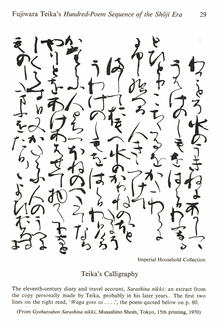This is an old revision of this page, as edited by Tristan noir (talk | contribs) at 04:43, 22 January 2013 (tweak in punctuation -- removing complete sentence from parenthesis). The present address (URL) is a permanent link to this revision, which may differ significantly from the current revision.
Revision as of 04:43, 22 January 2013 by Tristan noir (talk | contribs) (tweak in punctuation -- removing complete sentence from parenthesis)(diff) ← Previous revision | Latest revision (diff) | Newer revision → (diff)
The Sarashina Diary (更級日記, Sarashina Nikki) is a memoir written by Lady Sarashina (as she is commonly known), a lady-in-waiting of Heian-period Japan. Her work stands out for its descriptions of her travels and pilgrimages and is unique in the literature of the period, as well as one of the first in the genre of travel writing. Lady Sarashina was a niece on her mother's side of Michitsuna's Mother, author of another famous diary of the period, the Kagero Nikki. The personal name of Michitsuna's Mother is unknown, as it was common practice then not to mention a woman's birth name.
As with most works of the period, Japanese schoolchildren get only limited exposure to the work through small selections cited in their classical-Japanese textbooks.
The author and the book's content
Lady Sarashina (also known as Sugawara no Takasue no musume, the daughter of Sugawara Takasue, since her real name is unknown) wrote her memoirs in her later years. She was born in 1008 CE and in her childhood traveled to the provinces with her father, an assistant governor, and back to the capital some years later. Her remembrances of the long journey back to the capital (three months) are unique in Heian literature, if terse and geographically inaccurate. Here she describes Mount Fuji, then an active volcano:
It has a most unusual shape and seems to have been painted deep blue; its thick cover of unmelting snow gives the impression that the mountain is wearing a white jacket over a dress of deep violet.
Her memoirs start with her childhood days, where she shamefully remembers her joy at reading tales to the point of praying to the Buddha to be able to read all of them, and relegating spiritual life as a lesser priority, despite several dreams which she interpreted as admonishments from the heavens. She records her joy when presented with a complete copy of the Tale of Genji, and how she dreamed of living a romance like those described in it. When her life did not turn out as well as she had hoped, she blames her addiction to tales, which made her live in a fantasy world and neglect her spiritual growth. These records are impressive memories from her returning, that is, travel and dreams, her father and sister, her almost complete ignoring of her husband and sons, and day-to-day life.
She spent her youth living at her father's house. In her thirties, when she was rather old by Heian standards, she married and became a lady-in-waiting. She was too shy and old to make a career in court and too indifferent to her husband and children, who are barely mentioned in her diary. She stopped writing at some time in her fifties and no details about her death are known. Heian aristocracy were expected to express gloom and sorrow about the shortness of life, and Lady Sarashina seems to have been especially straightforward about it as each death in her life (especially her sister's and father's) made her life more painful.
Lady Sarashina's birth name is unknown, and she is called either Takasue's daughter or Lady Sarashina. Sarashina is a geographical district never mentioned in the diary, but it is alluded to in one of the book's poems and for some reason was chosen as the name for the whole work: she maybe mentioned Mountain of granny dumping (姥捨て山, Ubasuteyama, Obasute, appeared in original) in the Sarashina.
Manuscripts
The most authoritative copy of Sarashina Nikki is one produced by Fujiwara no Teika in the 13th century, some two hundred years after Lady Sarashina wrote the original. Teika copied Lady Sarashina's work once, but his first transcription was borrowed and lost; the manuscript he worked from was itself a second-generation copy of a lost transcription. To compound the problems, sometime in the 17th century Teika's transcription was rebound, but the binder changed the order of the original in seven places, making the diary less valuable and more difficult for scholars to understand. In 1924, Nobutsuna Sasaki and Kōsuke Tamai, two classical literature scholars, examined the original Teika manuscript and finally discovered what had happened, leading to a reevaluation of Sarashina's work. It is from this correctly re-ordered version that all modern versions are made.
Notes
- Morris, Ivan, trans.: As I Crossed a Bridge of Dreams: Recollections of a Woman in Eleventh-Century Japan. Penguin Classics, 1989 (reprint). ISBN 0-14-044282-0 (ISBN ) or ISBN 978-0-14-044282-3 (ISBN )
- ^ Nishishita, Kyoichi. Commentary. Sarashina Nikki. Rev. Kyoichi Nishishita. 1930. Tokyo: Iwanami, 1963.